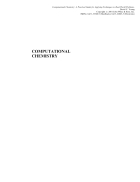




Mã tài liệu: 200732
Số trang: 398
Định dạng: pdf
Dung lượng file:
Chuyên mục: Khoa học công nghệ
Những tài liệu gần giống với tài liệu bạn đang xem
📎 Số trang: 292
👁 Lượt xem: 479
⬇ Lượt tải: 16
📎 Số trang: 240
👁 Lượt xem: 491
⬇ Lượt tải: 16
📎 Số trang: 607
👁 Lượt xem: 334
⬇ Lượt tải: 16
📎 Số trang: 372
👁 Lượt xem: 366
⬇ Lượt tải: 16
📎 Số trang: 580
👁 Lượt xem: 476
⬇ Lượt tải: 18
Những tài liệu bạn đã xem
 Computational Chemistry 1st Edition
Product Description A practical, easily accessible guide for bench-top chemists, this book focuses on accurately applying computational chemistry techniques to everyday chemistry problems. Provides nonmathematical explanations of advanced topics in
pdf Đăng bởi
baby_micky_9x
Computational Chemistry 1st Edition
Product Description A practical, easily accessible guide for bench-top chemists, this book focuses on accurately applying computational chemistry techniques to everyday chemistry problems. Provides nonmathematical explanations of advanced topics in
pdf Đăng bởi
baby_micky_9x